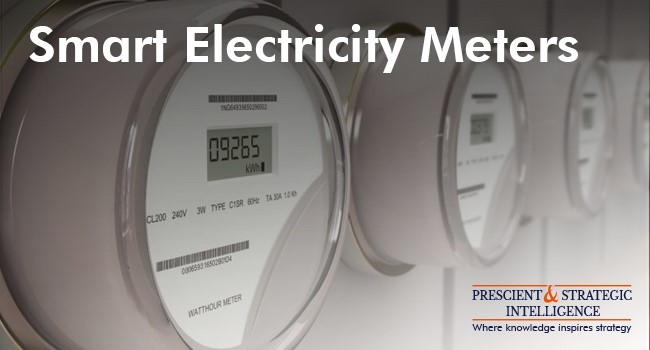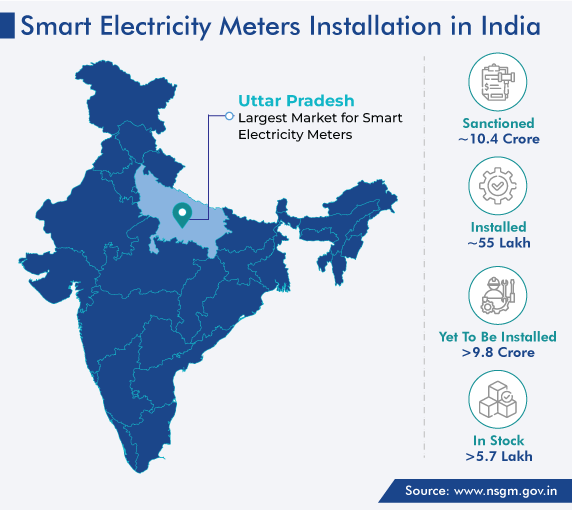Is Turning to Smart Electricity Meters, a Smart Move in India?
- Published Date: February 28, 2023
There is a lot of buzz about smart electricity meters, with the traditional electricity meters being replaced by these smart alternatives all over the world, especially in India.
The total number of smart meters sanctioned by the government agencies all over India were 10,39,42,338, 54,95,525 were installed, 9,84,46,813 are yet to be installed, and 5,70,417 are in stock as of February 2023.
The EESL has announced the installation of 30 lakh smart meters all over India under the Smart Meter National Programme. Over 10.5 lakh have been installed in Bihar, approximately 11.57 lakh in Uttar Pradesh, over 1.24 lakh in Rajasthan, more than 5.3 lakh in Haryana, about 64,000 in NDMC Delhi, and more than 74,000 in the Andaman Islands.
Agreements have been signed with the administrations and utilities in these regions for the extensive installation of smart meters. The ultimate aim is to install over 47 lakh of these by the end of 2023.

For the meters to do what they are designed for, IoT solutions are being procured from some of the top network providers in the country, for enabling two-way connectivity between distribution companies and consumers. Among the firms contracted by the EESL for this purpose are BSNL, Vodafone Idea, and Reliance Jio. Moreover, Robert Bosch, EDF Energy, and L&T are helping the nodal agency achieve smooth system integration.
Because India is taking giant steps toward the installation of smart electricity meters, especially prepaid ones, companies that provide these systems, as well as their individual components and related services, can expect a windfall in the coming years.
What Are Smart Electricity Meters?
The working of a smart electricity meter is exactly the same as a traditional meter, in that it measures, monitors, and records energy consumption. Though, there is a major difference.
An Advanced electric meter relays the information regarding the consumption of electricity directly to the utility operator, as it is a digital device with a communication module. These devices send the information every 15 minutes, eliminating the requirement for a meter reader.
Understanding the Working of a Smart Electricity Meter
A smart utility meter is able to take automatic readings of residential, commercial, and industrial electricity usage, which it transmits wirelessly to the discom. Furthermore, some variants help in the analysis of energy use trends during the peak and off-peak hours, thus helping predict future demand. This allows users to decrease their bills accordingly, without taking any action whatsoever.
Additionally, a single-phase electric meter has an in-home display, allowing users to keep a track of their total use of electricity and the price that is to be paid to the utility.
Types of Smart Electricity Meters
A smart meter is available in a couple of configurations—single-phase and three-phase.
The major consideration when choosing between them is the energy requirement. Customers using high amounts of power, including commercial and industrial enterprises, generally make use of a three-phase connection.
On the other hand, domestic electricity requirement is generally lower than industrial and commercial need. So, utility operators generally install a single-phase meter at homes.

Transmission and Distribution Losses in India
India’s transmission and distribution losses were more than 20% of all the energy generated in 2021, which is more than twice the global average. The ideal range of these losses is about 8%. These losses are decreasing, but are still more than many developed nations of the world.
This gap can be brought down even further with the use of smart electricity meters.
Utilities in J&K have the highest power transmission and distribution losses, while the states in the Northeast and East also incur high losses, underlining the lack of reforms in the power sector in these states.
Though, 15 state power discoms in Gujarat, Tamil Nadu, Andhra Pradesh, Karnataka, UP, West Bengal, Manipur, and MP narrowed their losses by over 10% in 2019–20. The capital city of Delhi had the lowest losses in the country, but still significant.
These losses result from the aging of the T&D infrastructure, thefts, and error in meter readings. This is why smart meters are being installed, so that the exact amount of power being supplied and that actually reaching customers can be ascertained.
Role of Smart Electricity Meters in Smart Grids
The smart meter is a vital constituent of a smart grid, which will provide economic, ecological, and social advantages for numerous stakeholders. The key factor determining the success of the smart meters is data acquisition, communication, and processing, which benefits the consumer, utilities, and the government as well.
Concept of Virtual Power Plant and Role of Smart Meters in It
India is stepping toward energy efficiency by increasing the production of renewable power. To manage the variable and often unreliable output of renewable energy sources, virtual power plants integrated with AI are being used.
In a VPP, energy is collected from solar plants, wind turbines, and other renewable establishments. The energy generation data is consolidated at a centralized operations control center, which then directs the output to the places that need it most.
The instantaneous demand for energy is calculated by analyzing the consumption data being fed through smart meters. Thus, with virtual power plants, India can make energy distribution and usage more efficient.
Idea of Smart Grids
A smart grid increases the efficiency of power transmission by the initiation of a bi-directional information flow between consumers and utilities.
This is done by the advanced metering infrastructure, wherein the data about electricity consumption is recorded timely and aggregated and analyzed by a smart meter. The data is transferred to utilities with the use of new-age communication systems, including HAN, NAN, and WAN.
Therefore, AMI not just communicates the data from smart meters to utilities but also transmits information to consumers from the utilities regarding peak demand and the per-unit cost of energy, thus allowing the consumer to use non-essential electrical appliances some other time.
Advantages of Smart Electricity Meters
For Utilities
- With the technology of advanced monitoring, there will be less or no requirement for meter readers.
- Load management can be done better during peak load times.
- Resources can be used more-efficiently, which also aids in conservation.
- The best tariff model for the electricity market is provided by these smart meters, enable discoms in better decision-making.
For Consumers
- Accurate and timely billing lessens the headache for consumers.
- Consumers can schedule electricity consumption considering the peak demand and instantaneous per-unit price.
- Consumers can even switch between renewable and conventional resources on the basis of the current tariff (in case they have on-site distributed power generation systems, such as rooftop solar installations).
- Feed-in and Export Tariffs
- Smart meters also enable customers to know how much feed-in and export tariffs they will get.
- Feed-in tariffs are given for the amount of power from the grid that is saved when people have some renewable power generation source onsite, for producing their own energy, rather than taking the power from the grid. The tariffs are generally calculated from the prevailing electricity rates given to generation utilities.
- Moreover, export tariffs are offered to people who supply the renewable energy generated by onsite installations to the grid, thus lessening the load on conventional power plants.
For Government
- The reassurance of smart meters will let governments perform better in monitoring power systems and implementing regulations.
- The use of renewable energy resources can be boosted, thus allowing countries to meet their emission reduction goals better.
- Blackouts and voltage fluctuations can be prevented by providing improved monitoring and forecasting the load on the power grid.
Smart Meters in the Indian Context
The Indian Ministry of Power is taking initiatives for meeting future energy requirements and supporting the thought of smart grids. As part of this effort, it has started 16 smart grid projects employing a combination of smart meters and numerous communication technologies, for increasing the reliability and efficiency of power systems.
The Indian Smart Grid Forum is engaged in the expansion of smart grid technologies in India. A few of the smart metering projects undertaken by it are the Puducherry Smart Grid Project, with more than 1,400 smart meters equipped with diverse technologies; and the Bangalore Pilot Project, which has benefitted 2,000 commercial and residential customers thus far.
Defining the Objectives of Smart Electricity Meters
The main objective of smart meters is guaranteeing systematic energy management with the active participation of the user, by allowing the latter to coordinate with utility corporations for making intelligent decisions based on consumption.
Moreover, the smart grid will improve the reliability and stability of power systems, employing AMI technologies. Improved outage management, augmented remote monitoring of power losses, and precise billing are the important advantages of smart meters. Therefore, the Indian government is engaged in extensive planning for the future development of this technology.
By clicking the Send Message below, you also agree to abide by the Terms and Conditions of the company
We respect your privacy. Your information will not be shared.
